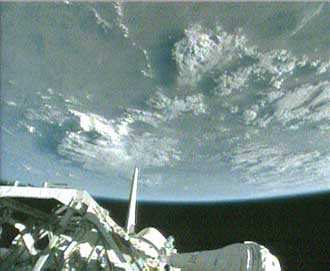Heat Shield Inspections Underway
ANN REALTIME REPORTING 06.09.07 1445 EDT: It's
not an area of significant concern just yet... but NASA is keeping
a close eye on an exposed segment of the space shuttle Atlantis'
aluminum skin, located atop the left orbital manuevering system pod
near the shuttle's vertical stabilizer.

NASA discovered the 3.5-inch tear in a thermal blanket Friday
night, as astronauts used a camera mounted on the shuttle's robotic
arm to examine Atlantis for signs of post-launch damage. Those
blankets, comprised of woven glass and silica, cover the areas of
the shuttle least susceptible to damage from the high heat of
atmospheric reentry.
"There's not a whole lot of concerns just yet," NASA spokesman
Louis Parker said Saturday morning.
CNN reports engineers are analyzing if -- and how -- the blanket
should be repaired. There is also the question of how that section
of the shuttle may have been damaged.
So far, there are no other signs of damage to the orbiter. A
camera mounted on the shuttle's external fuel tank did pick up a
chunk of insulating foam falling away from the shuttle 135 seconds
after launch, safely past what NASA considers to be the
aerodynamically-critical segment of the launch procedure. The
camera shows the foam falling harmlessly to starboard, with no
indication it contacted the orbiter itself.
"The tank performed in a magnificent way, despite having several
thousand repairs to it," shuttle program manager Wayne Hale said in
a Saturday press briefing. "(The debris) should not be a hazard
that late in the flight."
Original Report
Preparations are now underway for Atlantis' rendezvous Sunday
with the International Space Station.
 NASA reports that during
their first full day in orbit, the crew onboard space shuttle
Atlantis will inspect the orbiter's heat shield and prepare for
Sunday's arrival at the International Space Station.
NASA reports that during
their first full day in orbit, the crew onboard space shuttle
Atlantis will inspect the orbiter's heat shield and prepare for
Sunday's arrival at the International Space Station.
Just as on the three preceding shuttle missions, crew members
will use Atlantis' robotic arm and an orbiter boom extension to
check out the spacecraft's underside, nose cap and leading edges of
the wings for signs of damage to the orbiter's heat shield that may
have occurred during Friday's launch and climb to orbit.
A small hole in the space shuttle Columbia's heat shield, caused
by a falling chunk of insulating foam from the external fuel tank,
was responsible for the loss of that orbiter in February 2003.
In preparation for Sunday's activities, the crew will extend the
shuttle's docking ring and prepare tools they will use to
rendezvous and link up with the station. Docking is set for 3:38 pm
EDT Sunday.
The crew members are also slated to check out the spacesuits
they will use during the mission's three scheduled spacewalks at
the station. The major objective of the spacewalks is the
installation and activation of the station's newest component, the
Starboard 3 and 4 (S3/S4) truss segments. The S3/S4 is riding to
the international outpost inside the shuttle payload bay.
Frederick Sturckow, a Marine colonel, is the commander of
STS-117. Pilot Lee Archambault, an Air Force colonel, joins
Sturckow in the Shuttle's cockpit. Mission specialists James Reilly
II, Ph.D., Patrick Forrester, Steven Swanson, Ph.D., and John D.
Olivas, Ph.D., round out the crew.
STS-117 is also delivering Flight Engineer Clayton C. Anderson
to the station, to relieve astronaut Sunita Williams.
(Photo courtesy of NASA)
 ANN's Daily Aero-Term (04.14.24): Maximum Authorized Altitude
ANN's Daily Aero-Term (04.14.24): Maximum Authorized Altitude ANN's Daily Aero-Linx (04.14.24)
ANN's Daily Aero-Linx (04.14.24) Classic Aero-TV: 'We're Surviving'-- Kyle Franklin Describes Airshow Life 2013
Classic Aero-TV: 'We're Surviving'-- Kyle Franklin Describes Airshow Life 2013 Aero-News: Quote of the Day (04.14.24)
Aero-News: Quote of the Day (04.14.24) Airborne 04.09.24: SnF24!, Piper-DeltaHawk!, Fisher Update, Junkers
Airborne 04.09.24: SnF24!, Piper-DeltaHawk!, Fisher Update, Junkers




